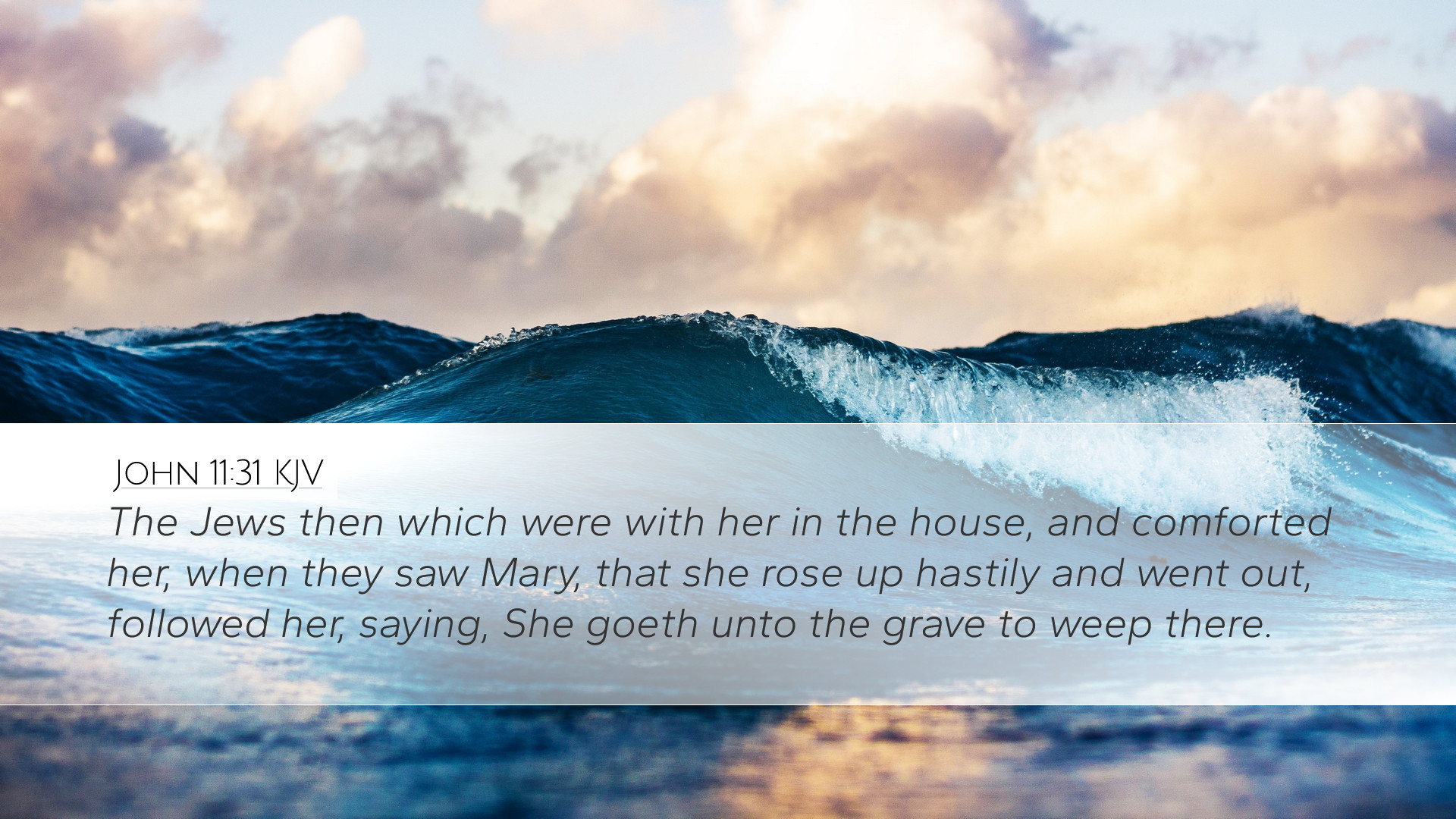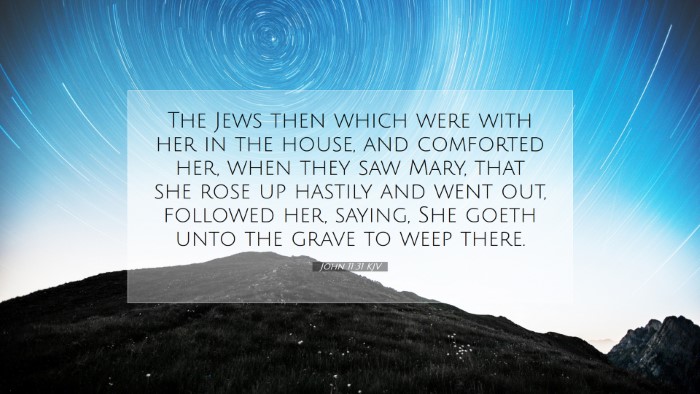Commentary on John 11:31
Bible Verse: "The Jews then which were with her in the house, and comforted her, when they saw Mary, that she rose up hastily and went out, followed her, saying, She goeth unto the grave to weep there."
Introduction
This verse forms a pivotal point in the narrative of the raising of Lazarus, showcasing the emotional landscape surrounding death and mourning. It captures the reactions of the Jews, highlighting both their empathy and cultural practices regarding grief.
Contextual Background
Understanding the cultural context of mourning in first-century Judea is essential. The Jews had specific customs for grieving, which included mourning for the dead for several days, showcasing their solidarity with the bereaved. This verse illustrates those customs in action as Mary receives comfort from those around her. It invokes themes of community support in the midst of sorrow.
Commentary Insights
-
Matthew Henry's Perspective
Matthew Henry provides a comprehensive view on the nature of grief, emphasizing that the Jews' concern for Mary shows the depth of communal bonds. He notes that Mary's action of hastily going to the grave was a natural response to loss, indicating that even in deep sorrow, there is a movement towards seeking the deceased. Henry highlights the importance of communal mourning: “They followed her in a spirit of sympathy, which reflects the innate human desire to share in one another’s suffering." This illustrates the meaningful connection between people during times of grief.
-
Albert Barnes' Thoughts
Albert Barnes elaborates on the scene's dynamics, pointing out that the Jews misinterpreted Mary's haste. He notes that they assumed she was going to the grave, influenced by cultural expectations of mourning rituals. Barnes states, “Their incorrect assumption serves as a reminder of how easily we can misread the intentions of others in times of emotional intensity.” This misreading underscores the need for understanding and clarity in interpersonal relationships, especially during challenging times.
-
Adam Clarke's Analysis
Adam Clarke delves into the emotional weight of grief portrayed in this verse. He emphasizes the collective nature of mourning and the role of societal rituals to process loss. Clarke notes, “Mary’s action was symbolic of a heart in anguish, one that seeks solace in the familiar spaces of loss.” He also points out that this narrative sets the stage for the miraculous act by Jesus, which reshapes the concept of loss and mourning in a profound manner.
Theological Implications
John 11:31 invites theological reflection on the nature of grief and comfort. It suggests that human experiences of sorrow are valid and shared within community contexts. The actions of Mary and the Jews reveal the communal aspect of mourning, which serves as a foundation for understanding how the Church might support one another in their times of sorrow. This also prepares the narrative for the introduction of Jesus’ compassion and authority over death, culminating in Lazarus’ resurrection, which fulfills both the immediate and eschatological hope.
Lessons for Pastors and Theologians
-
Encouraging Community Support: This passage serves as a reminder for church leaders to foster environments where communal mourning and support can take place. It calls for pastors to be present with their congregations, recognizing the need for shared grief and healing.
-
Understanding Misinterpretations: As illustrated by the Jews following Mary, it's vital for pastoral care to engage in empathetic listening. Misunderstandings can occur during vulnerable moments, making it crucial to remain sensitive to the emotions and intentions of others.
-
The Hope Beyond Grief: The narrative foreshadows the resurrection of Lazarus, inviting reflection on the hope that transcends death. Pastors can use this to proclaim the Gospel's promise of eternal life, providing comfort in the face of loss.
Conclusion
In summary, John 11:31 encapsulates the profound emotional realities of grief while simultaneously setting the stage for a significant theological revelation concerning life, death, and resurrection. By examining the insights offered by Matthew Henry, Albert Barnes, and Adam Clarke, we gain a deeper understanding of the nuances of human emotion and the communal aspects of mourning. This verse not only speaks to the immediate response to loss but also invites us into a larger narrative of hope and renewal, challenging both individuals and the church to engage meaningfully with grief.


